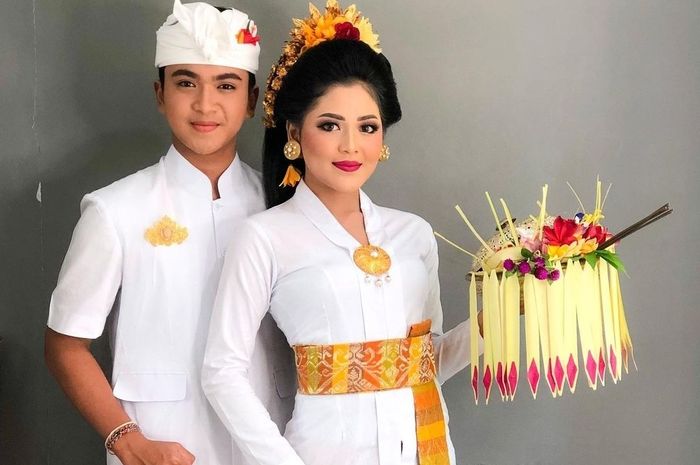Balinese Traditional Clothing – Bali is a province in Indonesia with a capital city called Denpasar. Bali is one of the islands in the Nusa Tenggara archipelago. Bali is the prima donna of Indonesian tourism, which is also rich in natural beauty, unique art, and culture.
Bali, as a complete tourist destination, has a variety of exciting tourist attractions, starting from Kuta Beach, Tanah Lot, Bedugul Lake, and Garuda Wisnu Kencana. Art and culture in Bali is also a tourist attraction.
Also, the typical Balinese clothing worn by the Balinese people every day makes this Island of the Gods feel thick with culture. Balinese dress varies greatly, even though the clothes look the same to the naked eye.
Each region in Bali has its characteristics and ornaments. It is also based on traditional activities or ceremonies, gender, social status, and age. You can start by recognizing the typical regional clothes to preserve Balinese culture.
Preserving the culture of the motherland can be started as early as possible.
Types and Names of Balinese Traditional Clothing
1. Balinese Kebayas
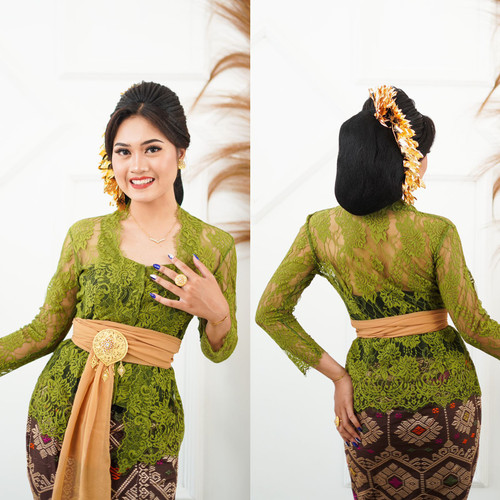
Balinese kebaya is a traditional dress worn by Balinese women. This Balinese kebaya can be made from various materials, but adding lace is one of the favorites of Balinese women.
Usually, Balinese kebaya will be worn with a corset. This corset is generally worn at the bottom by older Balinese women. Typically, the colors vary and are quite eye-catching.
Balinese kebaya is synonymous with bright colors; this has a philosophical value, namely to describe the joy and elegance of women in Bali. Balinese people have many traditional and religious ceremonies.
It starts with ceremonies that are happy, sad, and religious. Therefore, the kebaya is one of the essential clothes in the life of women in Bali.
When attending traditional ceremonies that are like, Balinese women usually use bright kebaya colors. Meanwhile, the kebaya used by Balinese women tends to be dark in color for conventional mourning ceremonies.
This dark color is worn because it is synonymous with sadness. They also don’t wear make-up or put their hair in a bun. Apart from the sad nature of the ceremony, they also did not have time to prepare for their performance.
In addition to traditional ceremonies, Balinese women wear kebaya for religious activities. One of the religious activities carried out by the Hindu-Balinese community is going to the temple. Kebaya is also used on piodalan day in a temple.
The kebaya worn is also the usual but with various colors, because they will be doing activities that require a lot of movement and sweating, so the chosen kebaya is comfortable.
2. Safari clothes
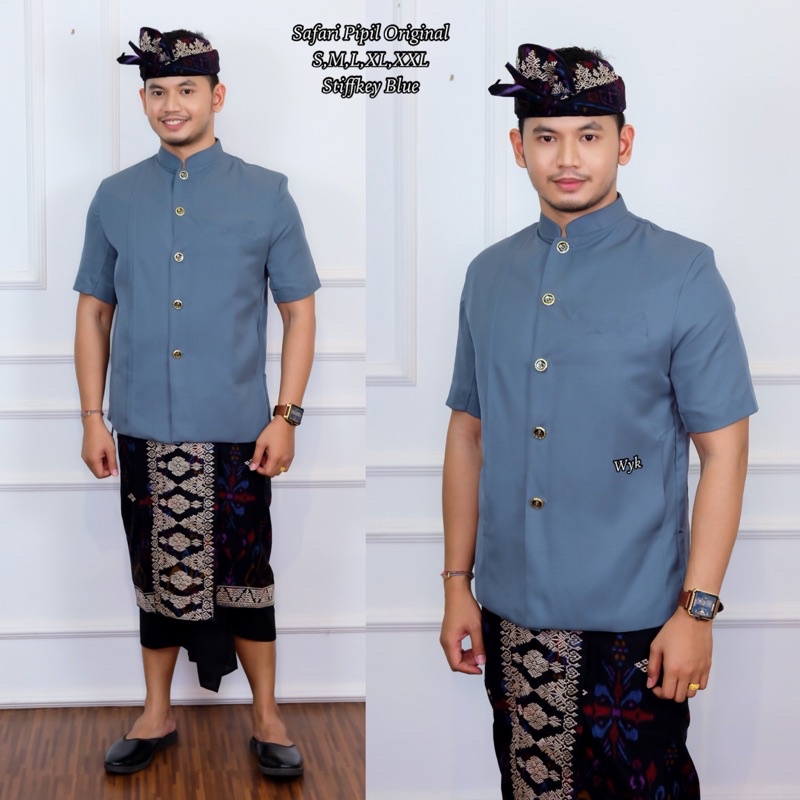
If Balinese women tend to wear kebaya, Balinese men wear safari clothes. This safari shirt looks like a shirt in general. However, the traditional garments that become Balinese clothes have a deep meaning. Every Bali man wearing this safari suit must maintain cleanliness, tidiness, and decency.
Safari shirts are generally white, with a collar and buttons, with pockets on the chest and at the bottom. The white color on this safari dress symbolizes purity and sacredness.
The meaning of these colors is expected so that Balinese men can always maintain their purity. This traditional dress is usually worn at conventional and religious events.
This safari suit has a unique collar. The collar of the safari shirt is in the form of a sports collar which comes from the development of a fallen collar that stands without an enforcer. Safari clothes are generally used with Kamen, a piece of cloth used to cover the lower body.
This Kamen looks similar to a sarong, but Kamen is usually made of thin cloth. Generally, men in Bali use two pieces of fabric to cover their lower body.
In addition to Kamen cloth, the use of this safari shirt is also accompanied by a headband. This headband is made of sewn material and shaped like a knot in the middle. Udeng is not only used with safari clothes but also often used with other Balinese clothes. Usually, udeng is used during worship or worn at special events.
3. Kamen cloth
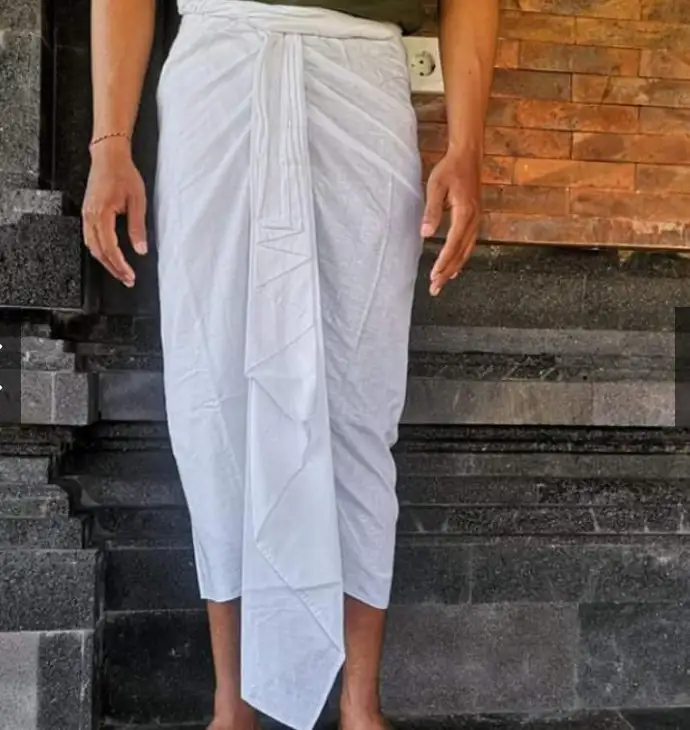
Kamen cloth is a cloth used to cover the lower part of the male body in Bali. Kamen is similar to a sarong, but Kamen has a prominent pattern and a square motif.
The material used to make Kamen cloth is a thin, smooth cloth. This Kamen cloth is not only used by men in Bali; women in Bali also often wear Kamen cloth.
This cloth is used to cover the waist to the ankles. The Kamen cloth is wound from left to right. This symbolizes that men must be able to hold dharma or truth.
The cloth worn must also have an inch distance above the soles of the feet. This symbolizes that men must be able to go further because they have more enormous responsibilities than women.
The Kamen cloth is wound from left to right, leaving a jag at the bottom. The slope is the edge of the fabric that touches the ground. By letting some of the material touch the ground, it symbolizes the virility of Balinese men. In addition, this also suggests that they will continue to serve the motherland.
Balinese women who wear Kamen cloth must be wrapped around it from right to left. Its use must be in the opposite direction to the way Balinese men use it. Wrapping the fabric from right to left is a sacred meaning or symbol as a balancing force for men. This also means that Balinese women must look after Balinese men in carrying out their responsibilities or dharma.
Using Kamen cloth for women is also accompanied by a building or stage. This Bulang or location looks similar to a corset. Bulang or stagen is a symbol of the womb. The use of the moon or stage is symbolized as controlling emotions.
4. Udeng head
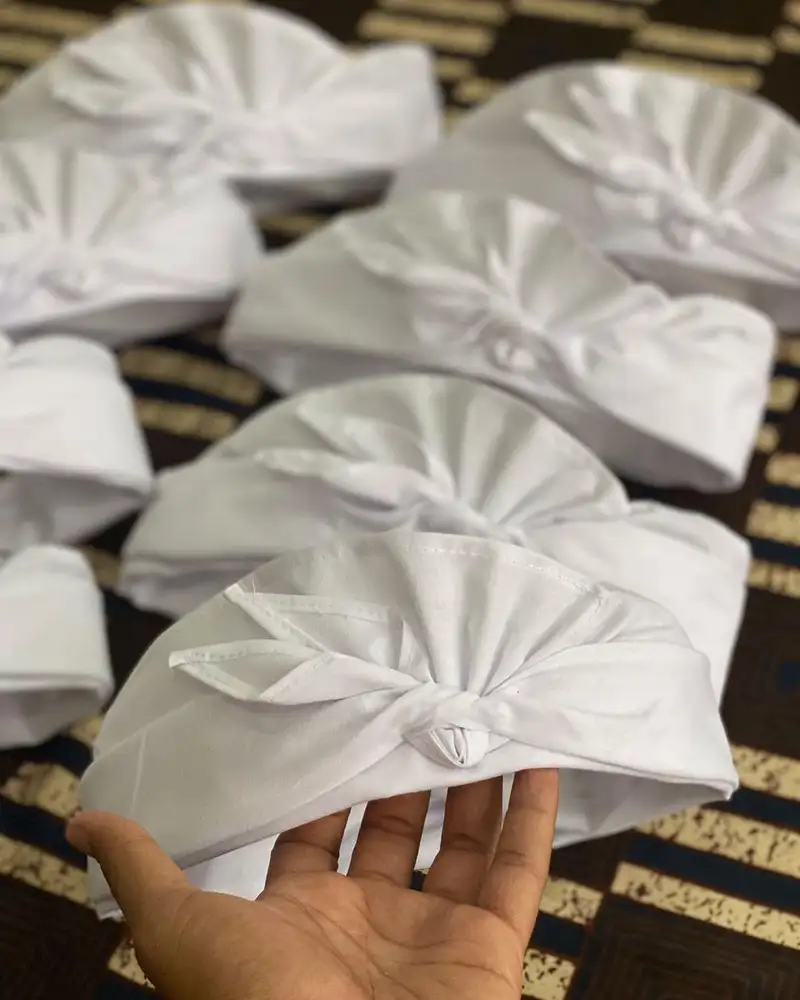
As mentioned above, using is a piece of equipment Balinese men wear in traditional ceremonies. This accessory helps cover the head, and Udeng is worn at various religious events by adult men and boys in Bali. Udeng is not only worn by rich people but middle and lower-class people.
Not everyone can make Udeng. Making use requires particular expertise to produce good service and has its uniqueness.
Udeng is made from a cloth which is then sewn and formed a knot in the middle. Balinese men usually wear at least two types of funding: made of plain fabric and used with patterns.
Plain dung is often used when Balinese men attend religious ceremonies. Meanwhile, colored or patterned using can be used for daily activities.
Men in Bali also use dung even though they do not participate in traditional or religious ceremonies. This high cultural awareness creates a characteristic that men are better off using daily.
The cloth that covers the head from these two sides, the right and left sides that meet each other in the middle, means the positive and negative sides meet and will become neutral. Udeng is an accessory that symbolizes self-control. In Bali, three types of dung are commonly known. Udeng jejateran, udeng, which is usually used when going to temples and social activities. Udeng Kepak dara, the udeng worn by kings. Finally, there is the dung beblatukan, worn by religious leaders.
5. Poleng
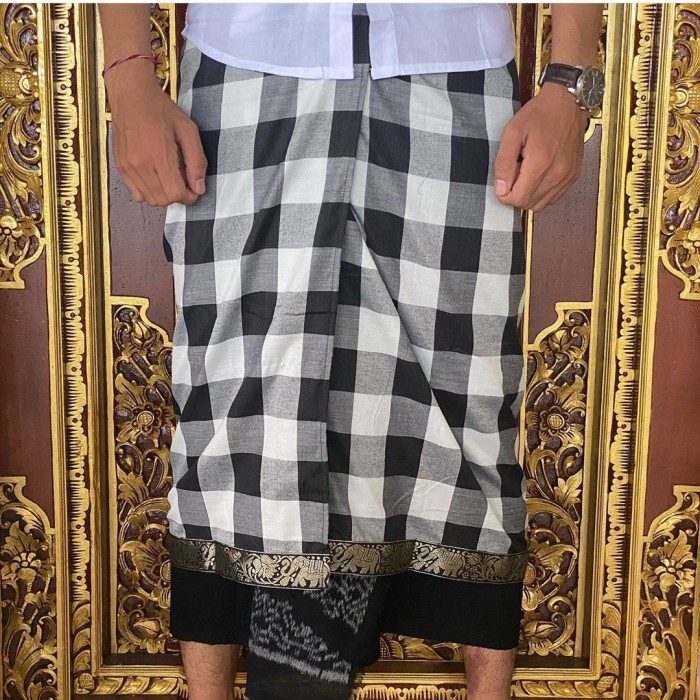
Checkered motifs in black and white may often be found when we go to Bali. Saput cloth, this bottom cloth, is a type of cloth that has a pattern like that. This cloth is usually worn on the top layer of Kamen cloth.
So, the Kamen cloth is used first, followed by handkerchiefs. This cloth is worn by tying it around the waist. It must also be used counterclockwise.
Saput cloth is generally used in religious ceremonies or weddings. There are various kinds of caput. One of them is Saput Poleng. Saput Poleng is a cloth of two colors, usually black and white.
Apart from black and white, there is also what is called Saput Poleng Sudhamala, which is white, gray, and black. Poleng tridatu, which are white, black, and red. The size of this cloth is also very diverse.
Poleng cloth is used on Balinese men’s bodies and often on umbrellas, monument banners, and statues. Not only sacred art objects but many trees in Bali are also wrapped in this Poleng cloth. Each color or pattern has a different philosophical meaning.
The philosophical meaning of the black and white black and white black and white black and white arrows are two contradictory characteristics, namely sound and evil, long and short, north and south, and so on.
Meanwhile, Saput Poleng Sudhamala reflects rwabhineda, which is mediated by alignment and differences in rwabhineda. This trikatu polling caput symbolizes the trigonal teachings, namely steam, rajah, and tamah, which mean wisdom, energy, and inhibition.
6. Prada belt and shawl
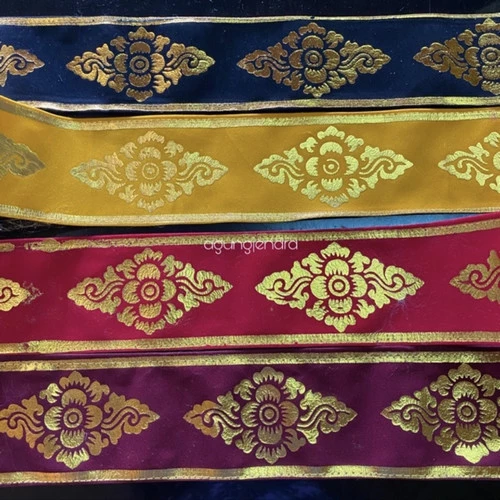
The Prada belt is a part of Balinese traditional clothing. Women in Bali usually wear this Prada belt. The Prada belt is worn with the kebaya, mixed and matched with Kamen cloth.
Prada belts usually have Balinese motifs and tend to be bright in color. This Prada belt means protecting the female body, especially the uterus, which is a gift from God.
The Prada belt aims to hold the Kamen cloth so it does not sag. In addition, the woman who wears this Prada belt becomes more graceful and radiant. Apart from having meaning to protect the uterus, the Prada belt is also considered a form of self-control and preventing evil deeds.
In addition to the Prada belt, shawls or sending are often used with other traditional clothing. This shawl is tied with a live knot on the left and is not covered by the shirt. The use of this shawl cloth has the goal that the wearer is always ready to educate his children so that later they become children who are always obedient to their parents. This shawl is a symbol that represents the behavior of the wearer. The typical Balinese cape has a variety of motifs so that it can be worn according to the model of the Kamen cloth.
7. Balinese women’s hairstyle
Women in Bali generally also style their hair when they wear traditional clothes. There are three types of hairstyles for girls. Unmarried women will usually style their hair half-folded and a half-left loose. This hairstyle is called pursuing longer. Pusung Gonjer symbolizes that the woman can still choose a man as her future partner.
Meanwhile, married women style their hair in a bun. This pursuing bagel bun is usually worn when Balinese women worship or attend certain traditional events. Sanggul pusung tagel has a chignon on the left side which is called atung pusungan. At the same time, the one on the right is called Magellan.
After that, there is the podgala pusung bun, a type worn by holy women or called sulinggih. This bun arrangement has a shape like a butterfly.
The bun is decorated with yellow cempaka flowers, white Cempaka, and sand. The three flowers have their symbols. The yellow Cempaka flower represents the symbol of Brahma, the white Cempaka represents Vishnu, and the sand symbolizes Shiva.
8. Payas Agung
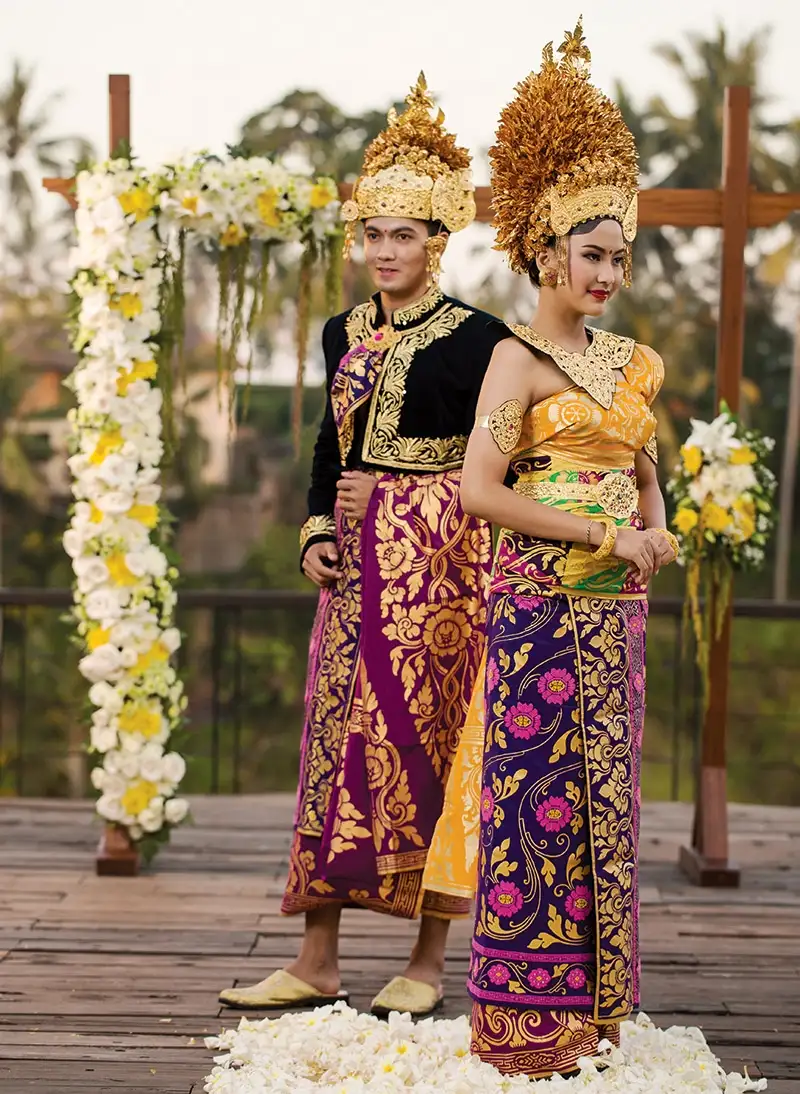
Payas Agung is the traditional dress of the Balinese people. This great pay is usually used during wedding ceremonies or cutting teeth. This clothing has a luxurious and memorable impression. Therefore the great pay as are not intended for various activities.
Payas Agung is worn with a towering crown and cloth of various colors worn by the bride.
The bride also wears a long tapis wrapped around from her chest to her toes. This cloth is then covered with a tank top and Kamen Prada covering the ankles.
They also use a make-up called srinata, a symmetrical arch on the forehead. The crown worn by the bride consists of sandat flowers and gold flowers. They also wear accessories such as bracelets on the left shoulder and waist.
9. Payas Madya
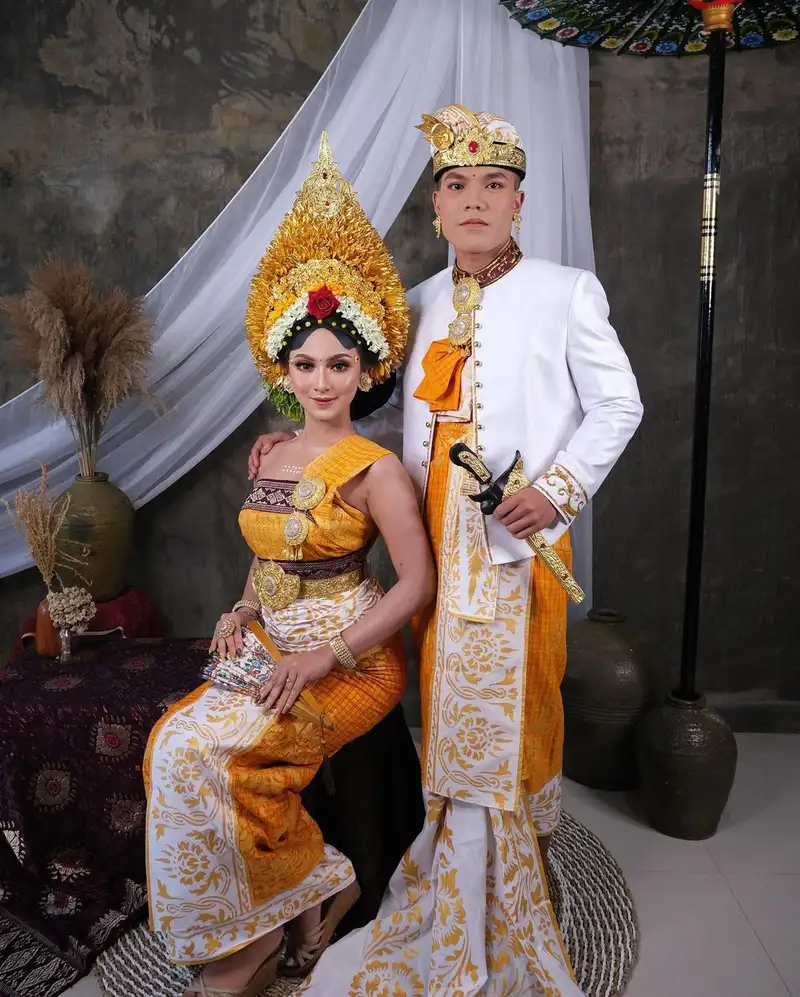
Payas Madya is slightly different from Payas Agung. Payas Madya has a more relaxed impression. Therefore this clothing can also be used in daily activities. The word madya itself has a middle meaning.
Payas Madya is not worn with too many accessories like Payas Agung. Payas madya can also be worn during religious rituals and also customary ceremonies.
10. Payas Alit
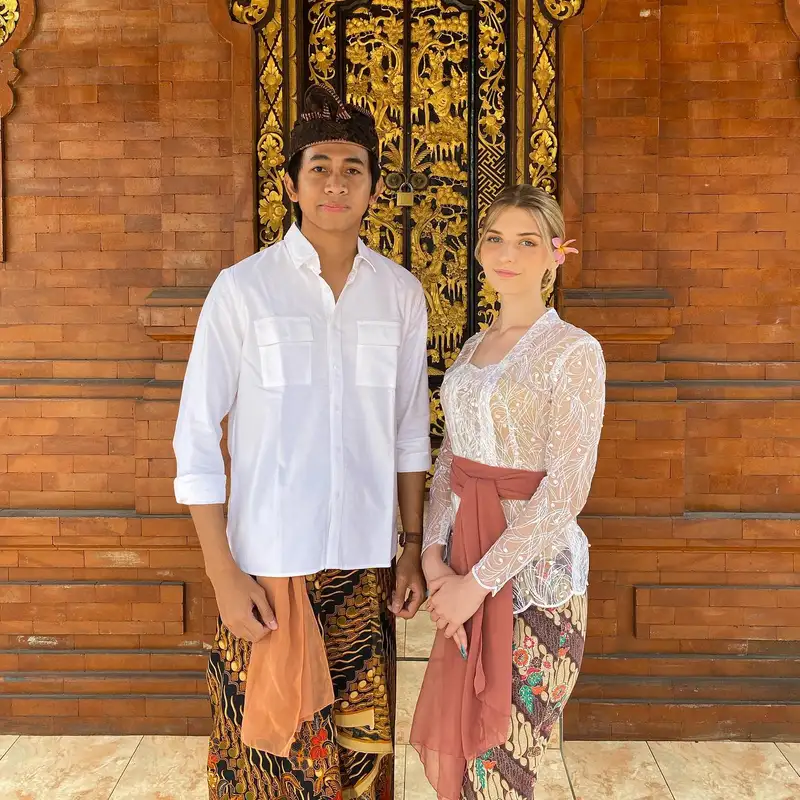
Payas alit is a traditional dress that can indeed be worn in everyday activities. Payas Alit is much simpler than Payas Agung and Payas Middle. Alit has a slight meaning, so it has a simple definition or a minor level.
Payas alit for men can wear a safari shirt or a koko shirt with an udeng head covering. Balinese people usually use payas disembarked for worship at the temple.

